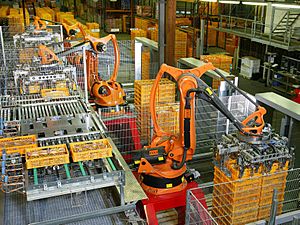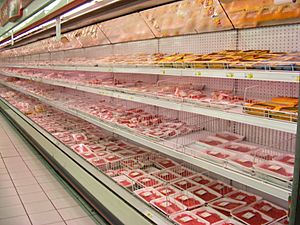Food processing facts for kids
Food processing is all about changing raw ingredients into food that people or animals can eat. Think of it like cooking on a really big scale! This industry takes fresh ingredients, like harvested crops or meat, and turns them into tasty and easy-to-use food products. They also make food for animals.
Contents
Why Food Processing Helps Us
Making Food Safe and Available
Food processing offers many good things. It can remove things that might be bad for us, keep food fresh for longer, and make it easier to sell and send food everywhere. It also helps make sure food tastes the same every time.
Thanks to processing, we can enjoy many foods all year round, not just when they are in season. It also helps send delicate foods far away without them spoiling. Plus, processing makes many foods safe to eat by getting rid of tiny germs that can make us sick. Modern supermarkets and long trips wouldn't be possible without these techniques.
Processed foods usually spoil slower than fresh foods. This makes them great for traveling long distances from where they are made to where people buy them. When these foods first came out, they helped solve food shortages. They also made many new foods available to everyone, improving what people ate overall.
Processing can also lower the chance of getting sick from food. Fresh items, like fruits, vegetables, and raw meats, can sometimes have germs that cause serious illnesses. Processing helps to remove or kill these germs.
More Choices and Convenience
Today's wide variety of foods is mostly possible because of food processing. It allows us to get foods from all over the world. It also reduces the hard work needed to prepare meals. This gives us easy access to many different foods that our ancestors could only dream of!
Processing can also make food taste much better.
Making food in large amounts is often cheaper than making meals from scratch at home. This means companies can make a good profit. For individuals, processed food offers convenience. However, it's usually not cheaper than making meals yourself.
Processed food has given people more free time. They no longer need to spend hours preparing and cooking "natural" foods. This extra time allows people more choices in how they live their lives. In many families, adults work outside the home. This leaves little time to cook with fresh ingredients. The food industry offers many products to help. For example, fully prepared frozen meals can be heated in a microwave in just a few minutes.
Modern food processing also helps people with allergies or conditions like diabetes. It allows them to find foods that fit their special dietary needs. Food processing can also add extra good things, like vitamins, to food.
Things to Watch Out For
Nutrient Loss and Additives
Any time food is processed, it can lose some of its healthy nutrients. How many nutrients are lost depends on the food and how it's processed. For example, heat can destroy vitamin C. So, canned fruits have less vitamin C than fresh ones.
New studies show that too much food processing might not be good for the helpful germs in our intestines. These germs are important for our health.
Using food additives is another thing to consider. Additives are substances added to food to improve its taste, look, or shelf life. The health risks of an additive can be different for each person. For example, sugar added to food can be risky for people with diabetes. In Europe, only approved additives can be used in food products. These approved additives get an "E number" (E for Europe). This makes it easier to know what's in your food. As we learn more about these additives, laws and rules are updated to make processed foods safer.
Contamination Risks
Food processing often uses big machines for mixing, grinding, chopping, and blending. These machines can sometimes cause problems. Over time, metal parts that touch the food can wear down and break off. This can put small metal pieces into the food.
To prevent this, food makers use special industrial metal detectors. These machines automatically find and remove any metal pieces. Large food factories use many metal detectors. This helps protect their machines and keeps consumers safe.
Where Food Processing Happens
Food processing happens in many places, including:
- Cannery (where food is put into cans)
- Cooking (on a large scale)
- Industrial rendering (turning animal parts into useful products)
- Meat packing plant (where meat is prepared and packaged)
- Slaughterhouse (where animals are killed for meat)
- Sugar industry (making sugar from plants)
- Vegetable packing plant (where vegetables are prepared and packaged)
Related pages
Images for kids
-
Michael Foods egg-processing plant in Wakefield, Nebraska
-
A form of pre-made split-pea soup that has become traditional.
See also
 In Spanish: Procesado de los alimentos para niños
In Spanish: Procesado de los alimentos para niños









